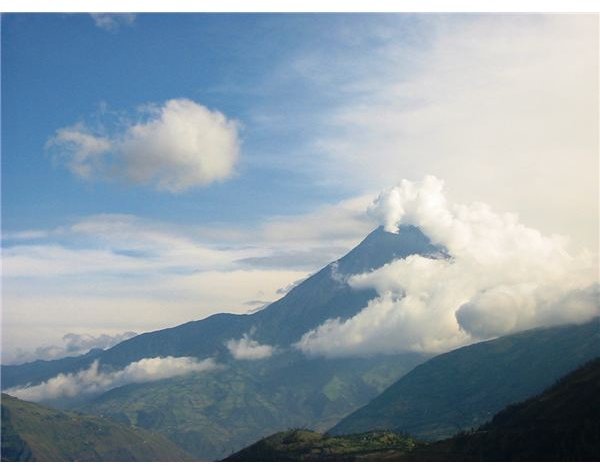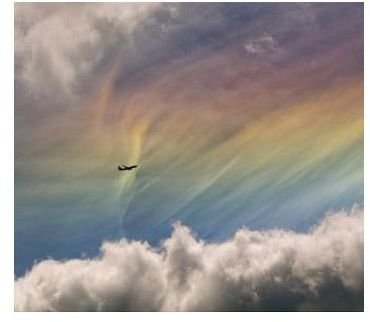How to Photograph Natural Phenomena - Tips & Tricks for the Beginner
How to Photograph Natural Phenomena
The plane banked to the left. I turned my head straining to catch a glimpse of the sun, now somewhere outside my field of view. Try as I might I couldn’t see where the sun was – my only way of figuring out our flight direction. Off to the right and just above though, we saw something else. Some passengers gasped in surprise.
“Look at that!” someone shouted.
It’s a wonder the plane didn’t tilt back to the right as virtually every passenger on the fully-booked flight crowded over to the right side to get a look at one of nature’s rarest natural phenomena – a “Fire Rainbow”. Although most often seen from high-flying aircraft, fire rainbows are occasionally visible from the ground too. Their exact cause has not yet been fully explained. Photographic exposure settings for fire rainbows should be for the brightest section of sky, with the focus set at landscape or infinity and a small lens aperture to ensure maximum depth-of-field. If you have time, bracket your exposures up and down by one or two stops.
Natural Phenomena Photos

The following natural phenomena will be considered in this article: earthquake lights - visual phenomena resulting from earthquakes which occur after sunset, fire rainbows, St. Elmo’s fire, the Aurora Australis and volcanic eruptions like this one of Galeras Volcano. Of foremost importance is the personal safety of the photographer when shooting under hazardous or potentially dangerous conditions. It is often advisable to shoot images from cover or the safest, farthest away position you can. A telephoto lens can zoom back in for frame-filling images. Just be sure to use a tripod or other camera-stabilizing device.
The Aurora Australis
In the southern hemisphere as you journey to the extreme south of the South American continent and on to Antarctica, you become increasingly likely to view the Aurora Australis. This evening sky-lit phenomena is the southern version of the far north’s <em>Aurora Borealis</em> visible in the northern latitudes of Russia, China, Mongolia, Canada and Scandinavia. The Aurora Australis and is visible from the extreme southern latitudes of Argentina, Chile and south of the Falkland Islands, as well as being most commonly seen in Antarctica (by scientific research station personnel), which is becoming an increasingly popular tourist destination.
St. Elmo’s fire
On occasion, ships at sea in the southern hemisphere are privy to the sight of <em>St. Elmo’s fire</em>. This electro-magnetic visual phenomenon appears in the form of a greenish glow covering wooden or metal objects on ships like masts of sails, antennae, flag and signal poles and railings. It is mentioned in sea-faring literature and sailing captain’s logs going back hundreds of years. There is even a mention of it in Herman Melville’s classic, “Moby Dick” and Shakespeare also alludes to it in his writing. Sometimes it is referred to in literature and layman reports as <em>St. Hermes</em> or St. Nicholas.
Photo Shooting Tips: Due to its usual dimness, St. Elmo’s Fire likely requires a short time exposure (one second, 1/15th, or 1/30th second) along with a wide aperture setting (_f_5.6, _f_2.8). Using a tripod or other camera-stabilizing device like a Gorilla-Pod, will minimize camera motion during exposures. If you go on a cruise, ask the crew if there’s a possibility of it along your itinerary.
The Natural Phenomena of Earthquake Lights
During an earthquake, huge amounts of energy are discharged as the earth tremors, the ground surfaces crack open and the pressure of the earth’s tectonic plates in motion are released and dissipated. During the past two decades, an increasing number of scientists, professionals and laymen alike have documented earthquake lights, the visible form of this released energy. Due to the radiation frequency of these lights, they are more commonly noticeable when earthquakes occur after sunset, very late at night or early in the mornings. More recent sightings of this rare phenomena have recently occurred in Japan, Peru and Colombia, as a dull, reddish glow or series of low-frequency wavelength flashes of reddish flashes or waves of light in the sky or low to the ground.
Photo Shooting Tips: To photograph earthquake lights, the camera should be in “night photography mode” or have a wide aperture setting (_f_8, _f_5.6) and a slow shutter speed (1/125th, 1/ 60th or 1/30th second) to capture as much available light as possible. The camera focus zone should be set at “landscape” or “infinity.”
Phenomena Related to Volcanic Eruptions

If you are fortunate (or unfortunate) enough to live or visit in regions of the world where there are active volcanoes, you have the possibility of capturing, not only volcanic eruptions themselves, but volcanic eruption-related phenomena as well. There are visible phenomena which occur during volcanic eruptions which are especially visible at night. Recent eruptions of <em><strong>Tungurahua Volcano</strong></em> (pictured here) beside the town of Baños, Ecuador or <em>Galeras Volcano</em> in Pasto, Colombia (pictured above) have been particularly interesting to photograph, especially at night. In addition to sometimes being able to view glowing molten lava and hot, incandescent rocks and gases, the sudden release of these large amounts of energy in a short time can create other visible phenomena like lightning flashes ball lightning visible spectrum wave energy.
Photo Shooting Tips: For personal safety reasons, among others, you’ll frequently want or need to use a telephoto lens to keep yourself as far from hazardous conditions as possible. Protect the camera with plastic coverings or wrap your camera in plastic to keep out dust, dirt, moisture and other potentially damaging materials. You should wear protective clothing as well, including ear plugs, a gas mask or covering for nose and mouth, a jacket, a cap or protective hat – a motorcycle helmet works well – protection for your eyes against corrosives, dust and airborne materials, and protective gloves. Be very wary of falling debris during and after volcanic eruptions and earthquakes. Tuck a pair of heavy cotton gloves in your camera bag, and a dust mask and safety goggles should be there too. Any hardware store will carry these items, so they’ll be quick and easy to get where ever you may travel to. A roll of plastic wrap to cover and protect your cameras may come in handy too.
Photographs of Natural Phenomena
Photographs of natural phenomena are a great treat simply because most photographers don’t have them. They sell well due to their rarity and will enhance the digital photography portfolio of any amateur or professional photographer. These are some of nature’s rarest sights and how to photograph these natural phenomena if you’re lucky enough to get the chance. Good luck.
